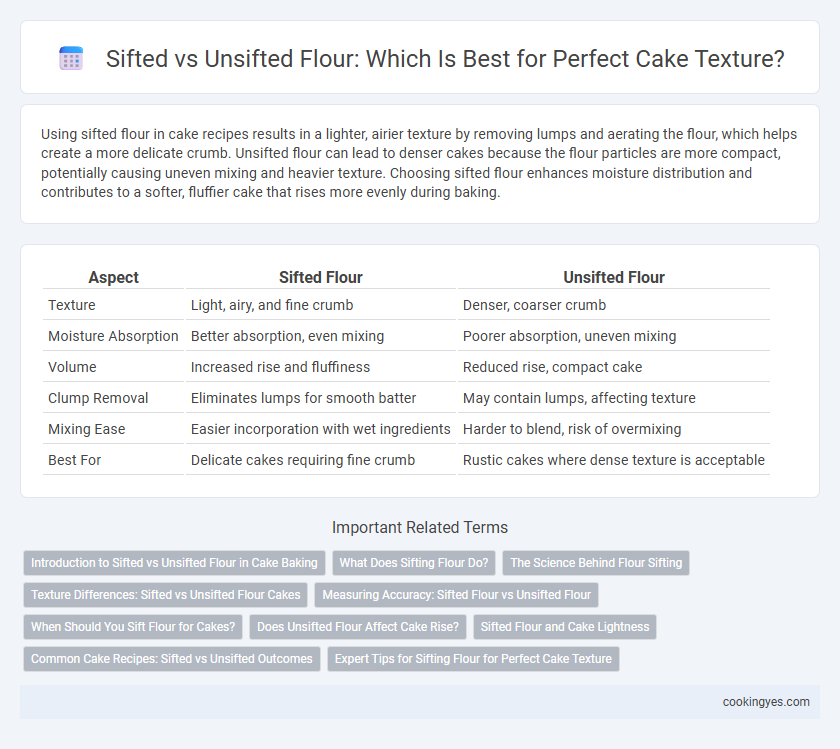Using sifted flour in cake recipes results in a lighter, airier texture by removing lumps and aerating the flour, which helps create a more delicate crumb. Unsifted flour can lead to denser cakes because the flour particles are more compact, potentially causing uneven mixing and heavier texture. Choosing sifted flour enhances moisture distribution and contributes to a softer, fluffier cake that rises more evenly during baking.
Table of Comparison
| Aspect | Sifted Flour | Unsifted Flour |
|---|---|---|
| Texture | Light, airy, and fine crumb | Denser, coarser crumb |
| Moisture Absorption | Better absorption, even mixing | Poorer absorption, uneven mixing |
| Volume | Increased rise and fluffiness | Reduced rise, compact cake |
| Clump Removal | Eliminates lumps for smooth batter | May contain lumps, affecting texture |
| Mixing Ease | Easier incorporation with wet ingredients | Harder to blend, risk of overmixing |
| Best For | Delicate cakes requiring fine crumb | Rustic cakes where dense texture is acceptable |
Introduction to Sifted vs Unsifted Flour in Cake Baking
Sifted flour is aerated and free of lumps, resulting in a lighter, more tender cake crumb, while unsifted flour can be denser due to compacted particles. Baking recipes that call for sifted flour typically achieve finer texture and even mixing, which can enhance overall cake volume. Understanding the difference helps bakers control moisture absorption and gluten development crucial for the desired cake consistency.
What Does Sifting Flour Do?
Sifting flour aerates and breaks up clumps, resulting in a lighter, more uniform texture essential for delicate cake crumb structure. Using sifted flour in cake recipes helps ensure even ingredient distribution and prevents dense, heavy cakes caused by compacted flour. Unsifted flour may produce a coarser texture and uneven rise, impacting the cake's tenderness and overall mouthfeel.
The Science Behind Flour Sifting
Sifting flour incorporates air, reducing density and breaking up lumps to create a lighter, finer texture crucial for delicate cakes. Unsifted flour remains denser and can result in uneven mixing, producing cakes with a heavier crumb and reduced rise. The science behind sifting highlights improved aeration and uniform particle size, which enhance gluten development and yield a tender, fluffy cake texture.
Texture Differences: Sifted vs Unsifted Flour Cakes
Sifted flour creates a lighter, airier cake texture by breaking up clumps and incorporating more air into the batter, resulting in a finer crumb and softer feel. Unsifted flour tends to produce denser cakes with a coarser crumb since the flour is more compacted and less aerated. Choosing sifted flour enhances the cake's tenderness and rise, crucial for delicate sponge and chiffon cakes.
Measuring Accuracy: Sifted Flour vs Unsifted Flour
Sifted flour is lighter and aerated, leading to more precise measurement and consistent cake texture by preventing dense, heavy batter. Unsifted flour can result in uneven clumps, causing inaccuracies in volume measurement and affecting the cake's crumb structure. Accurate measurement of sifted flour ensures better control over moisture content and contributes to a tender, uniform cake crumb.
When Should You Sift Flour for Cakes?
Sifting flour for cakes is crucial when recipes call for a lighter, airier texture because sifting aerates the flour and breaks up clumps, resulting in a more delicate crumb. Use sifted flour for sponge cakes, chiffon cakes, and angel food cakes where tenderness and fine crumb are desired; unsifted flour works fine for denser cakes like pound cake or butter cake. Always sift flour before measuring to ensure accurate volume and consistent cake texture.
Does Unsifted Flour Affect Cake Rise?
Unsifted flour can affect cake rise by retaining clumps and unevenly distributing leavening agents, leading to denser textures and less uniform crumb structure. Sifting aerates the flour, helping to incorporate air and dissolve clumps, which promotes better volume and a lighter, fluffier cake. For optimal rise and texture, cakes benefit from sifted flour to ensure even mixing and proper leavening activation.
Sifted Flour and Cake Lightness
Sifted flour plays a crucial role in achieving a light and tender cake texture by aerating the flour and removing lumps, which allows for even mixing and better incorporation of air into the batter. This process results in a finer crumb and softer cake consistency compared to unsifted flour, which can produce denser cakes due to uneven distribution and compacted flour particles. Bakers aiming for a delicate, airy cake often prefer sifted flour to enhance rise and overall lightness.
Common Cake Recipes: Sifted vs Unsifted Outcomes
Sifted flour creates a lighter, airier cake texture by breaking up clumps and incorporating air, which is essential in delicate recipes like sponge or chiffon cakes. Unsifted flour can result in denser cakes with a heavier crumb, often preferred in more rustic or moist cake varieties such as pound cakes or banana bread. Adjustments in mixing and ingredient ratios may be necessary depending on whether the flour is sifted or unsifted to achieve the desired cake consistency.
Expert Tips for Sifting Flour for Perfect Cake Texture
Sifting flour aerates the particles, resulting in lighter, fluffier cake texture and more even crumb structure. Expert bakers recommend sifting flour at least twice to remove lumps and ensure consistent mixing with other dry ingredients, preventing dense or gummy cakes. For best results, combine sifted flour gently with wet ingredients to maintain the aeration that creates a tender, moist cake.
Sifted Flour vs Unsifted Flour for cake texture Infographic

 cookingyes.com
cookingyes.com